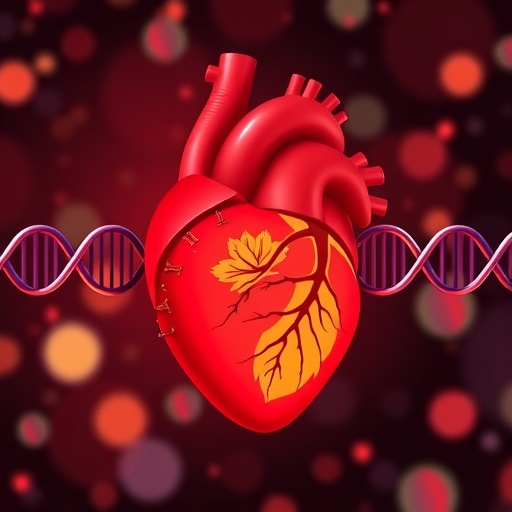Unraveling the Genetic Mysteries of Down Syndrome: HMGN1’s Role in Congenital Heart Defects
Recent scientific advancements have shed light on the intricate mechanisms underlying congenital heart defects (CHDs) associated with Down syndrome (DS), a genetic condition caused by the presence of an extra copy of chromosome 21. Approximately 2,600 children born each year in the United States with DS also exhibit various heart anomalies, predominantly atrioventricular canal (AVC) defects. This alarming statistic underscores the urgent need for a deeper understanding of how the overexpression of genes on chromosome 21 plays a critical role in the etiology of these heart defects.
In a groundbreaking study published in the prestigious journal Nature, a team of scientists, led by Dr. Sanjeev S. Ranade of Sanford Burnham Prebys, identified High Mobility Group Nucleosome Binding Protein 1, or HMGN1, as a pivotal contributor to DS-related congenital heart defects. This revelation not only addresses the longstanding question of why trisomy 21 is linked to devastating health issues but also opens new avenues for targeted therapies aimed at ameliorating these conditions.
The researchers embarked on this compelling journey by exploring the roles of specific genes on chromosome 21 that may exacerbate the effects of having an extra copy. Dr. Ranade articulated the research’s primary question: “What are the genes on chromosome 21 that are detrimental in triplicate?” By employing cutting-edge technologies, including CRISPR activation, the research team meticulously elevated the expression levels of chromosome 21 genes, facilitating the conversion of normal cells into a phenotype resembling that of Down syndrome cells.
HMGN1 is a multifaceted protein integral to various cellular processes, including the binding of nucleosomes—the foundational units of chromatin that package DNA within the cell nucleus. Its functions extend to the regulation of gene expression and the facilitation of crucial DNA replication and repair mechanisms. HMGN1’s presence was notably abundant in cells affected by trisomy 21, indicating its potential role as an instigator of the cardiac malformations observed in affected individuals.
Utilizing human pluripotent stem cells alongside mouse models of Down syndrome, the research yielded promising results. When HMGN1 levels were elevated, the differentiation of developing AVC cardiomyocytes veered toward an abnormal trajectory, prompting concerns about cardiac structural integrity. Conversely, the targeted deletion of one allele of HMGN1 in trisomic cells resulted in the restoration of normal gene expression, suggesting that moderation of this protein could pivotal in rectifying certain cardiac defects.
The significance of these findings cannot be overstated. Prior to this study, the direct correlation between HMGN1 and heart defects in the context of Down syndrome remained inadequately elucidated. This advancement provides a framework for comprehending the genetic underpinnings of other associated conditions, such as bone malformations and intellectual disabilities common in individuals with Down syndrome. The research fuels hope for the development of pharmacological interventions that may counteract the negative effects of an extra chromosome 21, leveraging the insights gleaned from the intricate functions of HMGN1.
The implications of this study resonate beyond congenital heart defects alone. With about 40,000 children born with CHDs each year in the United States, understanding the genetic factors involved can pave the way for innovative treatment strategies. Whether through pharmaceutical targeting or gene-editing technologies, the potential to address such a critical health issue offers a beacon of hope to families affected by these conditions.
Dr. Deepak Srivastava, a prominent figure at the Gladstone Institutes and UC San Francisco, served as the study’s senior author. His collaboration with Dr. Ranade and their team showcases the power of interdisciplinary efforts in unraveling complex genetic questions. Notably, the study garnered substantial support from various esteemed organizations, including the National Institutes of Health, emphasizing the collective commitment to addressing congenital disorders through rigorous scientific inquiry.
As the research community is reminded of the profound complexities of genetic disorders such as Down syndrome, the current study highlights the importance of creating a roadmap for identifying genes that may drive other congenital anomalies. The findings may serve not only as a catalyst for further research into cardiac defects but also spur developments in understanding other genetic conditions that warrant similar exploration. Ultimately, the goal is clear: to translate this knowledge into practical interventions that will significantly improve the lives of those affected by Down syndrome and its associated challenges.
In conclusion, the pivotal role of HMGN1 in trisomy 21-related heart defects presents a compelling narrative of hope and potential advancement in the field of genetic medicine. Continued research in this domain promises to unravel the mysteries surrounding other genetic disorders, enhancing our ability to treat and even prevent conditions that have long posed complex challenges to medical professionals and affected families alike.
Subject of Research: Down Syndrome and Congenital Heart Defects
Article Title: Myocardial reprogramming by HMGN1 underlies heart defects in trisomy 21
News Publication Date: 22-Oct-2025
Web References: Nature Article
References: Details not available
Image Credits: Credit: Sanford Burnham Prebys
Keywords
- Down syndrome
- Genetic disorders
- Chromosomal abnormalities
- Medical genetics
- Congenital defects
- Cardiac function
- Heart defects
- DNA repair
- Gene expression
- Molecular genetics




